#Agritecture Market
Explore tagged Tumblr posts
Text
From the Sky to the Field: How Drones are Transforming Farming Practices
"Drone technology is revolutionizing agriculture by providing farmers with real-time data and imagery, enabling them to make informed decisions about crop management, irrigation, and pest control. This level of precision helps to optimize yields and reduce resource use, ultimately leading to more sustainable farming practices."
Henry Gordon-Smith, CEO of Agritecture, on the use of drones in agriculture:
Introduction
Drones have revolutionized various industries, and agriculture is no exception. Drone farming represents the cutting edge of agricultural technology, promising efficiency, precision, and sustainability. The agricultural drone market is expected to grow from $1.2 billion in 2019 to $4.8 billion by 2024.
From scouting to security, drones are becoming common on both large and small farms. In many areas, drone use is already essential for large-scale precision farming operations. Data collected by drones help farmers optimize planting and treatments, potentially increasing yields by up to 5%. This blog explores the benefits, applications, challenges, and future prospects of drone farming, highlighting its transformative impact on modern agriculture.

What is Drone Farming?
Definition: Drone farming, or UAV (Unmanned Aerial Vehicle) farming, involves the use of drones to perform agricultural tasks such as monitoring crops, spraying pesticides, and analyzing soil.
Historical Context: Initially used for military and recreational purposes, drones have found significant applications in agriculture over the past decade, driven by advancements in technology and the need for precision farming.
Benefits of Drone Farming
Increased Efficiency: Drones can cover large fields quickly, performing tasks like spraying and monitoring in a fraction of the time it takes using traditional methods.
Precision Agriculture: By using sensors and GPS technology, drones can apply fertilizers and pesticides with pinpoint accuracy, reducing waste and environmental impact .
Cost Reduction: Although the initial investment in drone technology can be high, the long-term savings from reduced labour and input costs can be substantial.
Environmental Impact: Drones help reduce the overuse of chemicals and water, contributing to more sustainable farming practices .
Applications of Drones in Agriculture
Crop Monitoring: Drones equipped with multispectral and thermal sensors can monitor crop health, detect disease, and assess plant growth .
Soil and Field Analysis: Before planting, drones can create detailed 3D maps to analyze soil health, moisture levels, and nutrient distribution, aiding in better planning and resource management .
Planting: Some drones can plant seeds by shooting them into the soil with compressed air, which is especially useful in difficult-to-reach or hazardous areas .
Spraying: Drones can spray pesticides and fertilizers more evenly and precisely than traditional methods, reducing the amount of chemicals needed and minimizing human exposure to harmful substances .
Irrigation Management: By identifying areas of the field that are too dry or too wet, drones help farmers optimize irrigation and conserve water .
Sensor Technologies in Agricultural Drones
Agricultural drones are equipped with advanced sensor technologies that revolutionize farming practices. These sensors provide detailed insights into crop health, soil conditions, and more. Here are some key sensor technologies used in agricultural drones:
RGB Cameras: Capture high-resolution images for detailed crop analysis.
Multispectral Cameras: Is used to detect Nutrient deficiencies and early signs of disease.
Thermal Cameras:
Detects heat to identify plant stress and pests.
LiDAR: Create 3D terrain maps for topographical analysis.
GPS: Enables autonomous flight, accurate mapping, and issue identification.
Real-World ExamplesCase Studies:
Case Study: Enhancing Agricultural Efficiency with Krishi
Background
Modern agriculture increasingly relies on technological advancements to improve productivity and sustainability. One such innovation is the use of drones for various farming tasks, including crop management and irrigation.In this case study we will explore the impact of Krishi, a high-efficiency agricultural drone, on a medium-sized farm.
Challenge
Farmers often face the challenge of managing large areas of crops with limited resources and time. Traditional methods of spraying and monitoring can be labour-intensive and time-consuming.
Solution
The introduction of Krishi, an advanced agricultural drone, aimed to address these challenges by offering high efficiency and outstanding capacity.
Implementation
Krishi was deployed on a 50-acre farm to assist with crop management and irrigation tasks. The drone's capabilities were tested over a growing season, focusing on its efficiency and capacity.
Krishi was designed for maximum efficiency, covering 2-3 acres in a single flight. This exceptional capability saved considerable time and improved the overall effectiveness of crop management and irrigation systems. For instance, tasks that would typically take several hours were completed in just a fraction of the time, allowing for more precise and timely interventions.
Krishi's substantial 10-litre capacity enabled extended operation without frequent refills. This feature allowed the drone to cover large areas before requiring additional inputs, significantly enhancing convenience for the farmers. During peak spraying season, the drone managed extensive fields with fewer interruptions, ensuring consistent application of fertilizers and pesticides.
Results
The deployment of Krishi resulted in notable improvements in farm operations:
Increased Efficiency: The time required for crop management tasks was reduced by 60%, allowing farmers to allocate more time to other critical activities.
Higher Yields: The precision and timeliness of interventions led to a 15% increase in crop yields.
Cost Savings: Reduced labour and operational costs due to the drone's efficiency and capacity contributed to overall savings.
Krishi's high efficiency and outstanding capacity demonstrated significant benefits in enhancing agricultural productivity. This case study highlights the potential of advanced agricultural drones to transform farming practices, making them more efficient, cost-effective, and sustainable.
InJapan, drones are used extensively for rice cultivation, where they spray pesticides and monitor crop health . In the United States, large agricultural firms use drones for precision agriculture to improve crop yields and reduce costs .
Innovative Companies:
Companies like DJI, drone ,PrecisionHawk, and AgEagle are at the forefront of developing drone technology for agriculture, offering solutions that range from crop monitoring to automated spraying systems.
Challenges and Limitations
Regulatory Issues: The use of drones in agriculture is subject to strict regulations regarding airspace, privacy, and safety, which can vary significantly between countries .
Technical Limitations: Drones have limited battery life and may face difficulties operating in adverse weather conditions. The complexity of managing and analyzing the vast amounts of data they collect is another challenge .
Cost and Accessibility: The high initial cost of purchasing drones and the need for specialized training to operate them can be barriers for small-scale farmers.
Future Prospects
Technological Advancements: Future advancements in drone technology, such as improved battery life, AI integration, and better sensors, will likely enhance their capabilities and reduce costs .
Global Adoption: As drone technology becomes more affordable and accessible, its adoption is expected to grow globally, potentially transforming agricultural practices and improving food security.
Conclusion
Drone farming offers numerous benefits, from increased efficiency and precision to cost savings and environmental sustainability.The adoption of drone technology in the agriculture sector has the potential to revolutionize the way farmers manage their crops and improve yields. While challenges such as concerns about job displacement and a lack of knowledge and training persist, there are ongoing initiatives to promote the use of this technology and provide support to farmers looking to implement it.Despite challenges, its future looks promising with ongoing technological advancements
Final Thoughts: Embracing drone technology can significantly enhance agricultural productivity and sustainability, making it a vital tool for the future of farming.
ResourcesLinks:
PrecisionHawk: Drone Solutions for Agriculture
DJI Agriculture: Drones for Farming
Key Sessions at AgriNext Awards Conference & Expo
The AgriNext Awards Conference & Expo is not just a platform for showcasing innovations but also a hub for insightful sessions on cutting-edge agricultural technologies. One such noteworthy session is:
Standalone Session 2: 'Drones and Robotics in Precision Agriculture'
Date: 14 November 2024
Time: 12:15 PM - 12:45 PM
Venue: Crowne Plaza Dubai - Festival City
This session will delve into the latest advancements in drone and robotics technology, demonstrating their applications in precision agriculture. It’s a must-attend for anyone interested in understanding the future of farming technology.
0 notes
Text
Harvest London's Journey in Changing Urban Agriculture
Special thanks to Agritecture for sponsoring this edition! Discover their Designer Platform below! Key Takeaways: Sustainable Urban Agriculture Vision: Harvest London, founded by Chris Davies and Matt Chlebek, is pioneering in hydroponic vertical farming, aiming to create a sustainable food system and contributing to urban agriculture innovation. Strategic Crop Selection and Market Focus:…
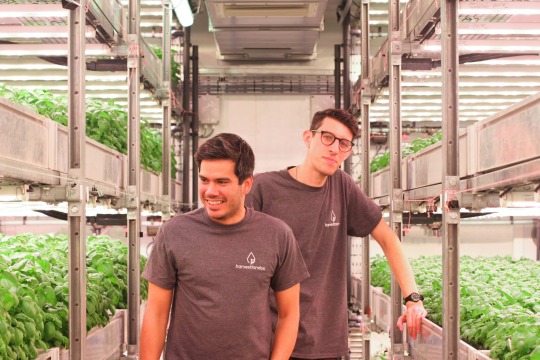
View On WordPress
0 notes
Text
Agritecture Market To Grow With Impressive CAGR During the Forecast Period
Environmental concerns are driving the growth in Global Agritecture Market in the forecast period, 2022-2026.
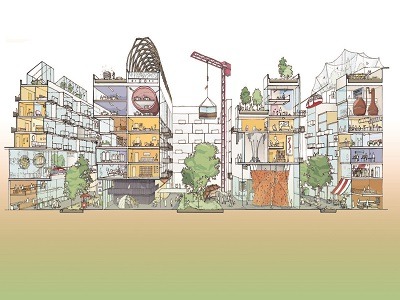
According to TechSci Research report, “Agritecture Market - Global Industry Size, Share, Trends, Opportunity and Forecast, 2016-2026”, The global agritecture market has a potential to project an impressive CAGR toward forces growth in the period, 2022-2026, on the account of growing adoption of environment friendly plant production and agricultural practices. Surge in the demand for the aesthetic plants like succulent plants, ornamental plants, grunge plants, etc. is further driving the growth of the global agritecture market in the upcoming five years. Also, unprecedented growth of global population has demanded for more residential infrastructures and the possibility of incorporating agricultural practices with modern ideation in the new building construction is further supporting the growth of the global agritecture market in the next five years. Agricultural practices in used warehouse, skyscraper, or shipping containers are new age techniques of incorporating agriculture with infrastructure architecture designing which is aiding the growth of the global agritecture market in the future five years. Moreover, increasing demand for urban agriculture is also substantiating the growth of the global agritecture market in the forecast years, until 2026.
Furthermore, high cost of involving technologies for the prolong sustenance of these agricultural practices might hinder with the future growth of the global agritecture market in the future five years.
Browse over XX market data Figures spread through 110 Pages and an in-depth TOC on " Global Agritecture Market"
https://www.techsciresearch.com/report/agritecture-market/8082.html
The global agritecture market is segmented on the basis of integration, structure, application, competitional landscape, and regional distribution. Based on integration, the market is differentiated between indoor, and outdoor integration. Outdoor integration is anticipated to hold the largest revenue shares of the market and dominate the market segment in the upcoming five years on the grounds of increasing demand for the environment friendly systems being incorporated in the various infrastructure. Moreover, idea of green buildings is further supporting the growth of the global agritecture market in the next five years. Also, lack of agricultural lands and demand for introducing agricultural practices in the corporate buildings, governmental building is further substantiating the growth of the global agritecture market in the future five years. Indoor integration is anticipated to register significant growth in the upcoming five years on the account of advancing technologies being incorporated in the vertical farming practices. Technologies like LED technology, hydroponic practice, are sustaining the market growth. Also, indoor farming practices protect crops from extreme climatic conditions with controlled environment agriculture technology, using artificial environment control systems, artificial lighting, and fertigation, thus aiding the growth of the sub-segment as well as the growth of the global agritecture market in the forecast period, until 2026.
Based on application, market is further fragmented into residential and commercial applications. Commercial applications of agritecture are anticipated to dominate the market and hold largest revenue shares of the market due to increasing demand for utilizing corporate infrastructure for added agricultural practices. Furthermore, depleting environmental conditions and concerns toward increasing carbon dioxide levels and depleting oxygen levels are influencing the growth of the sub-segment and growth of the global agritecture market in the future five years.
Some of the market players, dominating the global market are :
Agritecture Consulting LLC
AeroFarms LLC
Obyashi Corporation
Freight Farms, Inc.
Grow Pod Solutions
LettUs Grow Ltd.
FarmBox Foods
These market players along with new market entrants, are focused on extensive research and bringing innovative and advanced products. Technologically advanced manufacturing of the agritecture systems would aid in decreasing the cost of the production and aid the players in managing their investments. Moreover, initiatives from the government and private fundings would support the global agritecture market growth indirectly.
Download Sample Report @ https://www.techsciresearch.com/sample-report.aspx?cid=8082
Customers can also request for 10% free customization on this report.
“North America region is anticipated to dominate the global market analysis on the grounds of most of the researches based on agriculture practices and incorporation of agriculture designing with innovative infrastructure thinking, being conducted in the larger economies like the United States, and Canada. Also, the rapidly increasing market players in the region are supporting the growth of the global agritecture market in the upcoming five years. Additionally, increasing advancement of technologies like hydroponics, LED lighting, etc. that are further supporting the growth of the global agritecture market in the next five years. Moreover, lack of agriculture land due to increased industrialization is further substantiating the growth of the global agritecture market in the future five years. Asia Pacific region is also anticipated to register significant growth in the consecutive five years in future on the account of sudden increase in the population accounting for higher demand for residence and decreasing crop lands,” said Mr. Karan Chechi, Research Director with TechSci Research, a research based global management consulting firm.
“Agritecture Market - Global Industry Size, Share, Trends, Opportunity and Forecast, 2016-2026, Segmented By Therapy Type (Hormone Therapies, Monoclonal Antibodies, Signal Transduction Inhibitors, Gene Expression Modulators, Apoptosis Inhibitors, Others), By Disease Indication (Lung Cancer, Breast Cancer, Colorectal Cancer, Leukemia, Melanoma, Lymphoma, Others), By End User (Hospitals & Clinics, Cancer & Radiation Therapy Centers, Academic & Research Institutions), By Region”, has evaluated the future growth potential of global agritecture and provides statistics & information on market size, structure and future market growth. The report intends to provide cutting-edge market intelligence and help decision makers take sound investment decisions. Besides, the report also identifies and analyzes the emerging trends along with essential drivers, challenges, and opportunities in global agritecture market.
Contact
Mr. Ken Mathews
708 Third Avenue,
Manhattan, NY,
New York – 10017
Tel: +1-646-360-1656
Email: [email protected]
Web: https://www.techsciresearch.com
0 notes
Photo
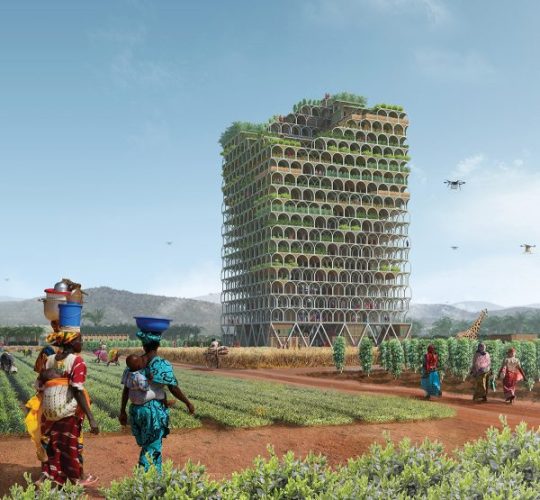
Awe Inspiring Mashambas Tower Takes First Place in Skyscraper Competition
Mashamba– Swahili, East Africa An area of cultivated ground; a plot of land, a small subsistence farm for growing crops and fruit-bearing trees, often including the dwelling of the farmer.
Over the last 30 years, worldwide absolute poverty has fallen sharply (from about 40% to under 20%). But in African countries, the percentage has barely fallen. Still today, over 40% of people living in sub-Saharan Africa live in absolute poverty. More than half of them have something in common: they’re small farmers.
Despite several attempts, the green revolution’s mix of fertilizers, irrigation, and high-yield seeds—which more than doubled global grain production between 1960 and 2000—never blossomed in Africa, because of poor infrastructure, limited markets, weak governments, and fratricidal civil wars that wracked the postcolonial continent.
The main objective of the project is to bring this green revolution to the poorest people. Giving training, fertilizer, and seeds to the small farmers can give them an opportunity to produce as much produce per acre as huge modern farms. When farmers improve their harvests, they pull themselves out of poverty. They also start producing surplus food for their neighbors. When farmers prosper, they eradicate poverty and hunger in their communities.
Mashambas is a movable educational center, which emerges in the poorest areas of the continent. It provides education, training on agricultural techniques, cheap fertilizers, and modern tools; it also creates a local trading area, which maximizes profits from harvest sales. Agriculture around the building flourishes and the knowledge spreads towards the horizon. The structure is growing as long as the number of participants is rising. When the local community becomes self-sufficient it is transported to other places.
The structure is made with simple modular elements, it makes it easy to construct, deconstruct and transport. Modules placed one on the other create the high-rise, which is a form that takes the smallest as possible amount of space from local farmers.
Today hunger and poverty may be only African matter, but the world’s population will likely reach nine billion by 2050, scientists warn that this would result in global food shortage. Africa’s fertile farmland could not only feed its own growing population, it could also feed the whole world.
First Place 2017 Skyscraper Competition
Pawel Lipiński, Mateusz Frankowski Poland
SOURCE
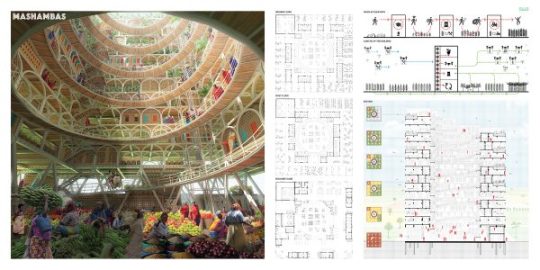
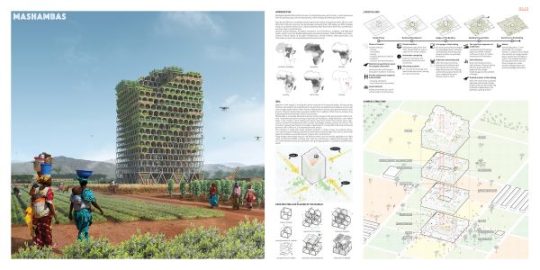
#Mashamba#Skyscraper Farm#Vertical Farm#Africa#Swahili#East Africa#Mashamba Skyscraper#Mashamba Vertical Farm#Education#skyscraper competition#skycraper#first place#agritecture#African Agritecture#African Skyscraper Market#African Market Agritecture#Pawel Lipiński#Mateusz Frankowski#double size
73 notes
·
View notes
Text
News in a Nutshell – w/e 23rd August 2019
Why 500 million bees have died in Brazil in three months
BBC News, August 20, 2019
Summary: More than 500 million bees have died in Brazil in the last three months. In the state of Rio Grande do Sul, 400 million dead bees were found - with beekeepers in four states reporting the mass deaths. Researchers have blamed the use of pesticides - chemical substances which are used to kill pests.
Relevance to ABC: Bees and pesticides as a trending media topic show no signs off fading, with the relationship between pesticide use and bee deaths very much a global issue. This particular article compares Brazil’s bee death statistics with other key international markets for food chains: US, Russia and South Africa just some of the countries that had pesticide restriction debates in recent months.
Who Speaks for the Bees? An Environmental Art Dinner Raises the Question
Vogue, August 20, 2019
Summary: Next time you pour almond milk in your coffee, spare a thought for the bees. Almonds are one of America’s largest monocrops, providing more than 80% of the world’s supply. Like onions, apples, avocados, cucumber, lemons, and watermelon, almond crops require wild honeybees to pollinate them, and because the naturally occurring honeybee population doesn’t come close to meeting the demand, millions of hives are shipped across the country each year to make up the massive gap. Monocultures, which grow huge expanses of only one crop year after year, have been directly linked to bee die-off as well as the spread of bee diseases.
Relevance to ABC: Given the detailed focus in this piece on the health of bees and the potential consumption/collapse impact on bee populations, this is worth being aware of. Whilst the focus is unlikely to result in further probing on the topic, it’s necessary for ABC to understand how media attention on health and environmental well-being is becoming more mainstream in fashion/lifestyle publications.
Former soap actor Max La Manna is on a mission to save the planet
Metro Online, August 21, 2019
Summary: Max La Manna is an influencer with 86.5k Instagram followers and is described to have a “passion for vegan living”. He was previously an actor on “Days of Our Lives” and is focusing on promoting zero waste in the UK
Relevance to ABC: Max provides planet-saving tips and shares vegan recipes with almonds and avocadoes heavily feature. The article addresses how he can be perceived as hypocritical due to almond’s high water consumption. Max would make for a good influencer partnership for messaging around zero waste at future consume events and media engagement.
European Regulators Issue Warning on Danger of Chlorpyrifos Prior to Release of Full Review
Beyond Pesticides, August 22, 2019
Summary: In early August, experts from European Union (EU) member states and staff members of the European Food Safety Authority (EFSA) announced their conclusion that chlorpyrifos fails to meet criteria for renewed approval for use, potentially moving the EU a step closer to an outright ban. Chlorpyrifos is a widely used organophosphate pesticide used on approximately 60 different crops, and most intensively on almonds, cotton, citrus fruits, grapes, corn, broccoli, sugar beets, peaches, and nectarines.
Relevance to ABC: Almonds are a crop that this particular type of pesticide is used on, meaning there is a risk that pressure could be felt from industry stakeholders that could require future messaging development. 12 plaintiff organizations have already been advocating for the registration cancellation of the compound used in agriculture, and with links to impairment of children’s learning, change in brain function, and altered thyroid levels, this is an extremely negative product for ABC to be associated with.
New natural pesticide alternative in development
Farming UK, August 22, 2019
Summary: A natural, sustainable alternative to pesticides which targets specific pests without harming pollinators is currently in development. Estimated global crop loss to pests – including insects, plant viruses and fungi – is around $100 billion every year, equating to a 40 percent loss in global agricultural production. But there is a significant need for innovative approaches to crop protection, driven by the need for greater food production, pest expansion linked to climate change and the push for more sustainable farming practices.
Relevance to ABC: Innovation in crop protection, being driven by food production needs, is relevant context for how food consumption trends and demands are driving technological innovation in the agriculture sector. With the wider environmental nod to establishing more sustainable farming practices, it is useful for ABC to remain abreast of these developments and industry conversations in real time.
Costa and Starbucks among coffee chains urged to drop plant milk surcharge
Sky News, August 22, 2019
Summary: Coffee chains have been urged to stop "taxing climate-conscious consumers" by dropping surcharges on plant-based milks. The group behind Veganuary, which encourages people to go vegan during the first month of the year, has made the plea to high street cafes like Costa and Starbucks to mark World Plant Milk Day. It says most shops charge between 20p and 50p extra for various plant milks, including soya, oat, almond and coconut, despite a recent study finding that a quarter of Britons were now drinking such dairy alternatives.
Relevance to ABC: The rise and ongoing interest in plant-based alternatives continues this week, which is relevant context to see how demands for almond milk in particular may grow. This piece calls for a drop in surcharges, which again shows how the industry is making progress towards diary alternatives becoming engrained in our day-to-day consumption like never before.
The future of food: Why farming is moving indoors
BBC News, August 23, 2019
Summary: Indoor farming can answer many of the questions being asked by today's consumers about the provenance, sustainability and health of the food they eat, according to Jeffery Landau, director of business development at Agritecture Consulting. While the industry is still young and trying to work out the right business models and direction, vertical farming has the potential to transform global food production as we know it.
Relevance to ABC: Farming progress and the move towards more alternative or experimental methods offer useful insights for ABC as they continue to grow. Identifying indoor farming methods as a future consideration offers an indication of the global food production trends to watch that may affect the future of almond bloom seasons.
0 notes
Text
Farm bill’s urban farming programs fuel growing sector
“It is really important for extension to refocus its attention on urban agriculture,” says Cohen. An office dedicated to urban agriculture can help do that.”
By Fran Howard Agri Puse Mar 14, 2019
The 2018 farm bill officially recognizes urban farmers — from those with community gardens to those operating multimillion-dollar vertical farms — with the creation of both a new office and a research, education, and extension initiative.
The Agriculture Improvement Act of 2018 is not the first time a farm bill has recognized the importance of urban farming; the urban garden program during the Carter Administration allocated funding to the nation’s largest cities in an effort to empower local communities to grow their own food.
The 2018 farm bill, however, is unprecedented in that it calls on the ag secretary to establish a USDA Office of Urban Agriculture and Innovative Production and appoint a senior official to serve as its director. The mission of the new office will be to “encourage and promote urban, indoor, and other emerging agricultural practices,” focusing on things like community gardens and farms located in urban areas, on rooftops, and using technologies like vertical or hydroponic farming.
Nevin Cohen, associate professor at City University of New York’s graduate school of Public Health and research director at the Urban Food Policy Institute, says while some USDA funding has been available for urban farms over the years, “it is important that urban agriculture is recognized as important enough within the agricultural production sector to warrant an office. It recognizes that new technologies are emerging — aeroponics, hydroponics, aquaponics.”
Urban agriculture is a rapidly growing, yet still very small, sector of the U.S. ag economy. According to Henry Gordon-Smith, founder and managing director of Agritecture Consulting, less than 1 percent of U.S. vegetables are currently grown by urban farms, but 20 percent of U.S. vegetables could eventually be grown in U.S. cities in community gardens, greenhouses, warehouses, shipping containers, on the rooftops of city buildings, and elsewhere.
Vertical farming alone, defined as the practice of growing food in vertically stacked layers, is growing at a rate of 24 percent a year, Gordon-Smith said. “The idea of policy leadership around this topic is spreading. Ten years ago, it didn’t even exist,” he said.
Gordon-Smith and others said that both policy and research around urban agriculture — whether at the federal, state, or local level — must respond to the rapidly developing, innovative entrepreneurial activity. Examples of these types of innovative urban farms include California-based Local Roots and New York-based Brooklyn Grange and Bowery Farming.
Sen. Debbie Stabenow, D-Mich., ranking member of the Senate Agriculture Committee, was a major force behind the urban agriculture provisions. Urban agriculture is growing rapidly in Detroit, as well as other cities, and sources noted that getting farm bill support from legislators in predominantly urban districts and states is easier if their constituents also benefit from the bill.
The farm bill also directs the secretary to assign a farm number to urban farms, gives authority to award competitive grants, and establishes an Urban Agriculture and Innovative Production Advisory Committee.
The committee is expected to help set up the competitive grants pilot project program, which is to increase compost and reduce food waste as directed by the farm bill. The grants can be awarded to urban farmers who operate a community garden or nonprofit farm, or educate a community on food systems, nutrition, environmental impacts, and agricultural production. Grants can also be made to help beginning farmers offset start-up costs.
Finally, the farm bill establishes the Urban, Indoor, and Other Emerging Agriculture Production Research, Education, and Extension Initiative. authorizing competitive research and extension grants to support research, education, and extension activities for the purposes of enhancing urban, indoor, and other emerging agricultural production. This section also provides $4 million in mandatory spending through 2023 and requires the secretary to conduct a census of urban, indoor, and other emerging agricultural production.
One urban operation, the Huerta del Valle farm in Ontario, Calif, east of Los Angeles, already has benefited from both public and private grants, including a four-year, $400,000 USDA National Institute of Food and Agriculture Community Food Projects grant, which allowed the four-acre nonprofit farm, which is now in the process of expanding, to begin paying its volunteer staff.
“We need additional support going forward,” Arthur Levine, project manager at Huerta Del Valle, said. “We are going from four acres to 30 acres (at several sites). We are looking to get more USDA support so we can scale up. The infusion of grant or foundation funding is critical to projects like ours,” says Arthur Levine, project manager at Huerta del Valle.
Huerta del Valle and other urban farms in California also benefit from state legislation, including the 2013 Urban Agriculture Incentive Zones Act, which allows cities and counties to provide landowners a tax incentive if they let their land be used for urban agriculture for a period of at least five years.
Other grants that benefit urban farmers are also available through the state. For instance, Huerta del Valle will receive $1 million in reimbursement funding over five years to compost waste under a multimillion cap-and-trade grant awarded to the city of Ontario. Levine plans to apply for a USDA loan so the farm can buy the $350,000 in equipment it needs to undertake the project and then repay the loan once the farm receives the grant money.
“The farm bill provisions create an opportunity for urban farms to tap into new sources of funding,” said Cohen. “Urban farms will be counted for the first time and having a designation as a farm makes it clear what parcels qualify for lower taxes” in California as well as incentives provided by other states, counties, or municipalities, says Cohen.
Rachel Surls, Los Angeles County’s sustainable food systems adviser at the University of California, agrees that including urban farms in the U.S. Census of Agriculture and giving each farm a number is a good first step for USDA. “We don’t know what urban farmers’ needs are, how many there are, or what their farms look like,” Surls says.
A recent study by graduate students at the University of California, Los Angeles that looked at urban farms in the county found that of the 1,261 verified urban agriculture sites, 761 were school gardens, 382 were commercial operations, and 118 were community gardens. The study also showed that the county’s urban farmers traveled 13.9 miles to distribute their goods, compared to 46.8 miles traveled by vendors of the Los Angeles County farmers market.
“Most of the products (sold by urban farms) are marketed as local and pesticide free,” Gordon-Smith said. “Local is becoming very popular with millennials; they want to buy products that contribute to the local economy.” Products are also marketed as sustainably grown or grown by family owned farms, he adds.
Urban agriculture also focuses on food equity and social justice, Surls says, but many of the newer high-tech startups that are interested in vertical farming are also interested in making a profit. Many urban farms are multidimensional in that they sell a portion of their goods at a low price in the neighborhood in which they farm and the rest at a higher cost to commercial ventures such as restaurants or grocery stores.
“The central issue in this space is education and training. New people are entering the space with no experience or knowledge of farming,” Gordon-Smith said. “This industry is moving so fast; it’s sort of like a Silicon Valley.”
The focus of USDA funding needs to be on helping existing urban farmers and new entrants gain the farming skills they need and as well as the marketing expertise needed to commercialize their products, sources said.
“It is really important for extension to refocus its attention on urban agriculture,” says Cohen. An office dedicated to urban agriculture can help do that.” In terms of implementation, USDA has not yet announced any timelines.
Read the complete article here.
from Gardening http://cityfarmer.info/farm-bills-urban-farming-programs-fuel-growing-sector/ via http://www.rssmix.com/
0 notes
Photo
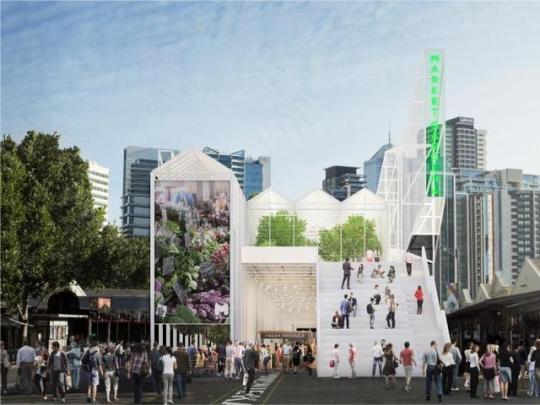
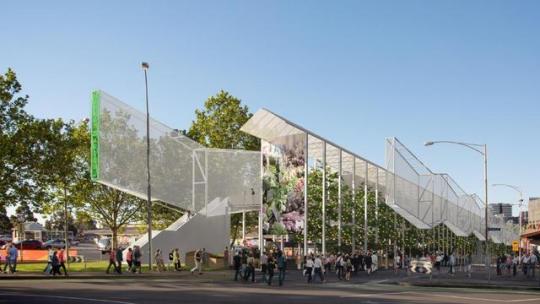
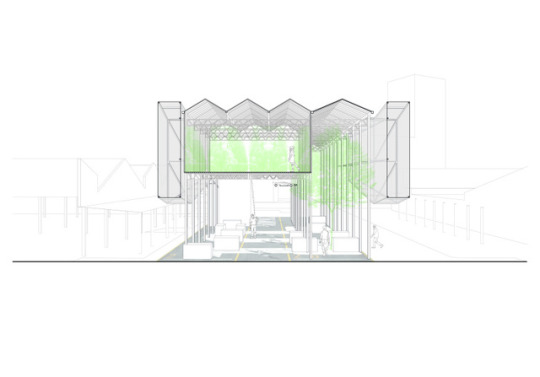
Queen Victoria Market in Melbourne is Adding an Elevated, Greenhouse-Style Pavilion
One of Melbourne's favourite inner-city shopping spots is moving up in the world, literally. An “urban greenhouse” that will be used to educate the public about food production is set to be approved for Queen Victoria Market. Melbourne City Council has released images of the proposed structure, which will also provide a home for displaced traders under the market’s $250 million redevelopment.
The two-storey building will run for 264m along Queen St with a maximum height of 13m. Fruit and vegetable traders due to the refurbishment of market sheds A and B will be housed on the ground floor. The first floor will feature an area to grow plants, fruit and vegetables sustained by a hydroponic system.
“This urban greenhouse is proposed to be used as an educational resource to promote knowledge of food production for the general public,” said a management report to be considered at a city council meeting on Tuesday.
Lord Mayor Robert Doyle has previously said the $5 million temporary project was a “very Melbourne solution” to relocating traders, and he predicted some would want to stay there after the market revamp was complete.
The report to councillors recommended a permit be issued. The new building would feature lightweight materials and “sensitive modern design (that) will adequately respect the existing market and wider precinct”.
SOURCE
16 notes
·
View notes
Link
10 notes
·
View notes
Link
2 notes
·
View notes
Link
2 notes
·
View notes
Photo
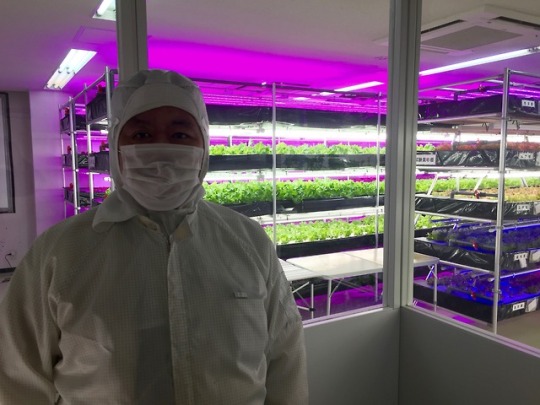
ISLANDS OF AGRICULTURAL INNOVATION: INDOOR FARMING IN ASIA
What’s the real state of the indoor farming industry, beyond all the marketing and hype? How are food systems and societies actually adapting to these new forms of production and distribution? These were a couple of the large questions on Jacob Eisenberg’s mind when he decided to leave his job and travel to Japan, Singapore, and Taiwan last fall to seek the answers for himself.
Since that point of inception until his return flight home, Jacob journeyed through the three island nations visiting urban farms, meeting with farm operators and association representatives, and observing the failures and successes that define indoor farming at this present moment.
To share his findings with the world, Jacob created Agri-Future as a space to post firsthand accounts of his adventures within the intersection of food, technology and sustainability. This article is the first part to an Islands of Agricultural Innovation series that will share Jacob’s trip and bring his detailed accounts of Asia’s indoor farming landscape to Agritecture readers far and wide.
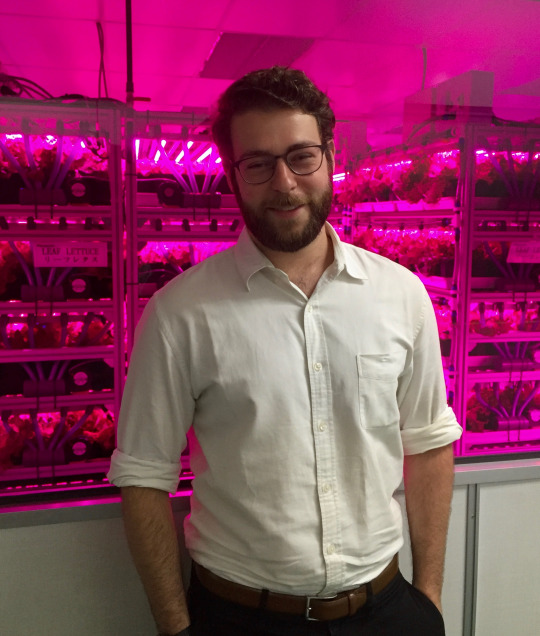
Jacob Eisenberg visiting the Veggie Life Plant Factory headquarters in Singapore during his journey throughout Asia. This article is Part 1 of a series that will bring Jacob's adventures to Agritecture readers across the globe. (Credit: Jacob Eisenberg)
“My curiosity first began looking at urban environments,” Jacob explained, adding that he has for many years had “a fascination with the development of cities, particularly of ancient cities and their relation to the natural environment.” For a while, he wanted to become an archeologist or anthropologist.
Similar to countless others, Jacob’s particular interest in urban farming took root while reading The Vertical Farm by Columbia professor Dickson Despommier, in 2011. “Something just clicked with that book,” Jacob reflected. “Even though it was such a novel idea at the time, it helped to address in my mind so many issues that I was trying to grapple with: sustainability, overpopulation, climate change, pollution.”
“There's so much optimism in that book,” Jacob added, “and being able to suspend reality and just imagine future possibilities made me very passionate and excited.”
This experience reading The Vertical Farm happened to coincide with the start of the Arab Spring, when food prices were having enormous geopolitical implications. Jacob was actually in high-school and studying abroad in China at the time, where he says the situation became particularly tense. “The whole experience really solidified my fascination with food’s relationship to the urban environment and to societal challenges and opportunities,” said Jacob.
During college, Jacob was able to pursue his new passion further with a study-abroad program that took him to São Paulo, Cape Town, and Hanoi. “We wanted to see what the state of urban agriculture was in these rapidly developing cities,” Jacob said. While traveling, he interviewed over 60 small-scale urban farmers, each grappling with different challenges and opportunities around growing food in some of the world’s fastest growing cities.
This experience clearly stuck with Jacob, because it wasn’t long after college that he decided to leave his job and go off on a similar adventure of his own. Jacob knew by now that he wanted to be somewhere within the ag-tech space, he didn’t know exactly where, but he was irreversibly attracted to the opportunities.
“Indoor agriculture is by no means the silver bullet,” Jacob writes on his site, “but it does offer a revolutionary opportunity to re-envision our food system — combining six thousand years of agricultural knowledge with precision technologies and food sourcing strategies of today and tomorrow.”
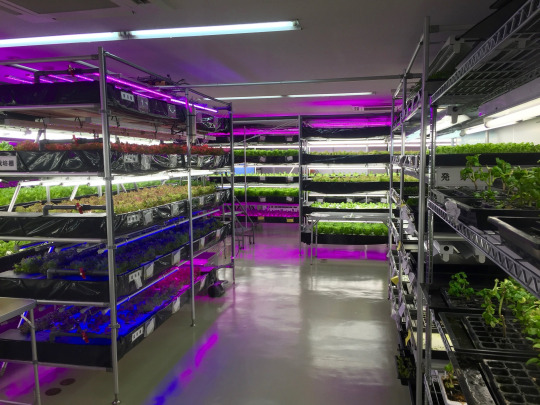
Mahoroba Suikoen Plant Factory in Nara, Japan. In Vertical Farms, or Plant Factories as they're known in Japan, plants are grown hydroponically in stacked layers. Different color LED lights are used to emphasize different attributes during plant growth. (Credit: Jacob Eisenberg)
For some, the prospect of leaving one’s job and venturing off to see the world would have been too daunting of a thought to ever actually pursue. But for Jacob, it was merely practical.
“My thought process at the time was: If I'm really passionate about learning more about this industry, then how can I see the actual state of indoor agriculture?” he said. “I saw this as such a tremendous and unique educational opportunity—well worth the time and preparation to use my savings from my job. I think that the best learning happens on the ground with the people actually doing the work. For me it was my jump into the world of indoor agriculture, instead of working my way up through a technical or business program.”
For this new journey into the world of ag-tech, Jacob selected three countries where he would explore the indoor agriculture industry and visit with farmers and technology providers: Japan, Singapore, and Taiwan.
You may notice some immediate similarities between these places, and for Jacob at least two of them were intentional.
This first obvious similarity is that each country is in Asia, but this wasn’t done simply to make the travel logistics easier. “I always had my eye on what was going on in Asia,” Jacob explains, “and I do speak Mandarin.” He’d also been paying close attention to the local food blogs in Asia and noticed that there's a strong focus on food quality and safety at this moment, leading entrepreneurs more and more into the realm of controlled environment agriculture as a way to recapture consumer trust.
All three countries were also selected because they are islands that are heavily dependent on food imports, which renders them extremely vulnerable to climate or geopolitical events and market fluctuations that are entirely outside their control. Singapore, for example, currently imports over 90% of the food consumed in-country. “They're the most predisposed locations to be food insecure in the near future,” Jacob explains, which has also made them some of the most innovative and important places when it comes to urban farming.
“These countries also have very limited farming land given the size of their populations,” he adds, “plus they each have fairly high levels of recent economic development and similar consumer classes that have diets high in plant based foods.”
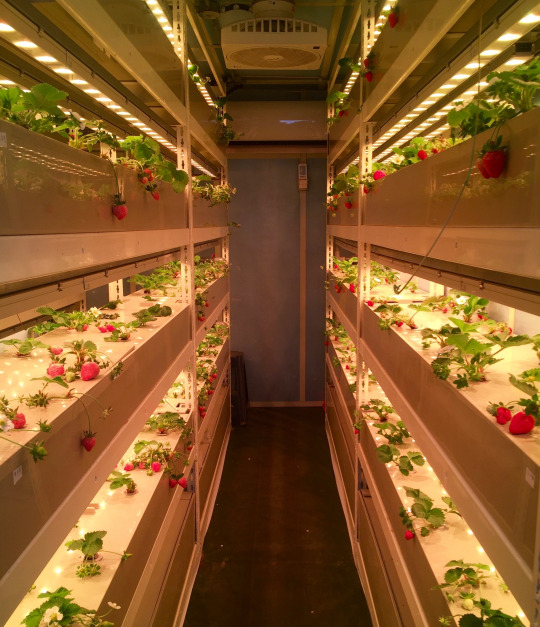
Strawberries growing hydroponically at a cultivation test facility outside of Taipei, Taiwan. (Credit: Jacob Eisenberg)
However, as Jacob discovered, not everything in the three island nations is similar. Despite their shared need to become more self-reliant in terms of food production, Jacob also discovered throughout his journey that each country’s indoor agriculture industry has many unique factors surrounding it.
“Taiwanese exploration into this space is often overshadowed by mainland China,” Jacob explained, “which is really unfortunate because there is so much going on in Taiwan with technology around indoor farming, such as horticultural lighting and automated systems.”
He also observed that Taiwanese entrepreneurs “are doing an incredible job of developing different business models for their farms, which are usually on a smaller scale and more diverse in nature than what you find in Japan.” Japan and Taiwan are similar, however, in that each country has a lot of industry associations, such as the more famous Japan Plant Factory Association, whereas these are not as commonplace in Singapore.
In Singapore, however, indoor agriculture currently enjoys an unparalleled amount of government support. The Singapore government has gotten behind urban agriculture in a number of ways, including recently instituted incentives for developers to integrate urban agriculture into new construction. However, “navigating the certifications for food safety and quality is still challenging for starting operations, even with all the government support,” Jacob noted. “I think this highlights the difficult regulatory environment that exists everywhere around urban farms, due to their very nature of being all at once a food business, manufacturer and office space— municipal regulators just don’t know how to deal with these sorts of unprecedented businesses.”
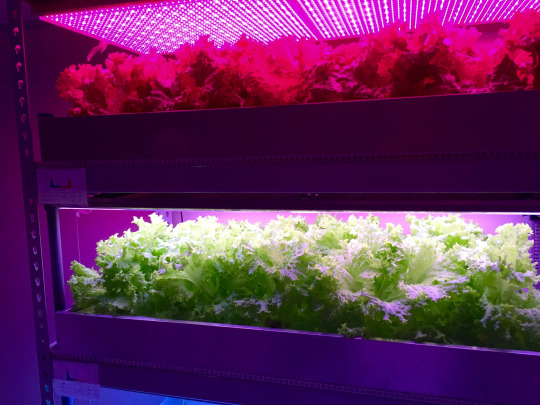
Lettuce growing in a vertically stacked hydroponic system under LED lights at National Taiwan University. (Credit: Jacob Eisenberg)
Without a doubt, Jacob’s journey confirmed a suspicion that he already had: Japan, Singapore and Taiwan are right up there with the global leaders in indoor agriculture. But when pressed to say which nation is currently leading the world, Jacob was reluctant to point towards any single country.
“There's no real leadership in indoor agriculture yet from any one country, in my experience,” Jacob said. And his reason for this is simple: no one model can be exported everywhere, at least not yet. “I think that the Netherlands are incredible with what they've done in terms of glass greenhouses, for example, but their greenhouses can't be used in Taiwan with their monsoon rainstorms,” he explained.
Excluding greenhouses and speaking strictly about vertical farms, “Japan has had a decent start ahead of the competition with their Plant Factories,” Jacob adds, “but they still have their fair share of challenges too before they can be easily dubbed the leader.”
Be sure to stay tuned in coming weeks as we continue this Islands of Agricultural Innovation series and share Jacob’s detailed accounts of the indoor farming world in Asia.
#urban agriculture#vertical farming#plant factory#hydroponics#asia#sustainability#plants#urban farming#islands#double-size
57 notes
·
View notes
Photo

SMART CITIES ARE FORGETTING ABOUT SOMETHING: FOOD
By Henry Gordon-Smith
Although we remain in the early stages, it is clear that a ‘Smart City’ revolution is sweeping the world. Technology driven solutions are being used to rethink and reshape the way that urban areas function. These solutions bring with them the promise of future cities that are more efficient with resources, more equitable for residents, and more resilient to climate events.
As with any young revolution, there is still a lot to learn in terms of what works and what should be included. Urban agriculture, for example, despite its unique ability to ameliorate a multitude of issues plaguing urban areas, is often strangely left out of the Smart City discussion.
Despite this fact, the urban agriculture industry has continued to grow immensely with an ever increasing demand for nutritious local produce. AgriFood Tech investment reached $10.1 Billion in 2017, including $200 Million in Series B funding for vertical farming company Plenty.
LEARN MORE AT AGRITECTURE XCHANGE
Urban Agriculture Entrepreneurship
In the last few years, my firm Agritecture Consulting has been in the unique position of working with over sixty urban farming projects around the world. From these experiences, two things have become abundantly clear. First, urban agriculture faces significant challenges as an industry. Many companies have made faulty assumptions about their market or their costs, and because of this many of them have failed.
But, second, I have also witnessed the incredible innovative spirit of the entrepreneurs who are driving this industry forward. It is abundantly clear that our current food system model is flawed, and urban farming pioneers will not rest until every process and piece of equipment has been fully optimized to make new, more sustainable and profitable models that transform food production globally.
It became very apparent early on in our consulting work that most entrepreneurs had brilliant concepts but were in need of technical guidance, and so we focused on feasibility studies and farm designs to assist new companies as they developed their business models.
One prime example is Rob Laing, an experienced tech entrepreneur and home chef who wanted to revolutionize the way Michelin starred restaurants source produce by growing on-demand specialty crops in a vertical farm in Manhattan. Agritecture Consulting helped transform Rob’s concept into a viable vertical farm called Farm.One, and also helped him install the farm and recruit their head grower. Now, the farm has expanded to a second location in Manhattan after selling out of the first.
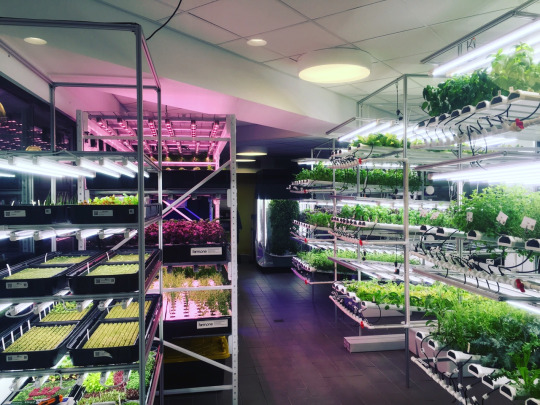
Farm.One’s first location in Lower Manhattan. (Photo: Farm.One)
In addition to the needs on the entrepreneurship side, it also became readily apparent that the urban farming industry is siloed and frequently disconnected from the outside world. To address this we have created workshops and conferences that focus on bringing people of diverse backgrounds together and introducing urban agriculture to a wider audience than just ag-tech entrepreneurs.
In partnering with the City of Atlanta, for example, we have brought togetherindividuals from across sectors of government, technology, farming, finance, etc. in order to facilitate the idea sharing that will spur ahead the next innovative urban agriculture models. Working directly with the City’s Director of Urban Agriculture, Mario Cambardella, Agritecture accelerated a unique brand ,“AgLanta,” to connect both high-tech for-profit and community-focused urban farmers with one another and the City. This culminated in two major conferences, a business development strategy to attract commercial urban farmers to the City of Atlanta, and also a roundtable where farms pitched to City agencies. Our partnership with Atlanta is another example of the work needed to drive local food systems forward.
Around the world, some regions remain highly dependent on food imports due to a variety of reasons such as limited water, land, and trained growers. We are also focusing our efforts in these places, where we see both the local desire and the capacity (thanks to recent innovations in agriculture) to become more self-sufficient in terms of food production. In Qatar, Agritecture proposed a context-specific agriculture incubator to respond to the nation’s urgent need to grow more food locally. The program embodies Agritecture’s approach: beginning with detailed market research and a study of the region’s potential for agriculture, followed by a comprehensive plan to attract new farmers, empower them through knowledge and incentives, and finally launch their new ventures with sustainable local agriculture in mind.
Cities and Agriculture
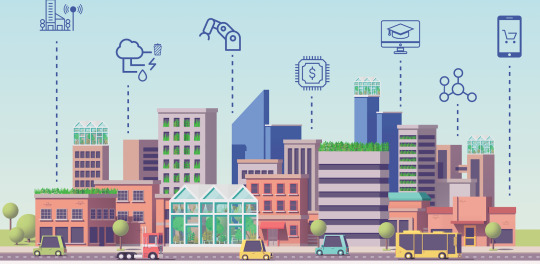
Smart City Agriculture. (Image: Agritecture)
Urban agriculture is not the solution to our food system crisis, but it is and will continue to be an essential component of how every country, region, and city restructures their food system to make fresh food supplies more available, resilient and ecologically friendly.
It is my deeply held belief that just like energy, transportation and internet access, the processes of food production and distribution are integral parts of the urban ecosystem. Similar to other system components, agriculture should be supported through smart policies that are data driven and context specific. The path forward for resilient cities and communities should and must include thoughtfully planned urban agriculture.
Some cities around the U.S. and abroad have begun the initial stages of implementing policies to encourage the industry’s growth as a critical part of local and regional food systems. In Los Angeles, for example, the Los Angeles Cleantech Incubator provides a space where urban farming companies can pilot their models. In Atlanta, a Director of Urban Agriculture ensures that municipal support is consistently available to local farmers.
Many other cities have passed zoning ordinances and started programs to promote the expansion of urban agriculture. In Boston, Article 89 comprehensively addressed where different forms of urban farms should be permitted within the city. In Minneapolis, the Homegrown local food program brings municipal and community actors together to research and plan out future supportive policies. In Paris, a municipal initiative ‘Parisculteurs’ aims to dedicate a third of the city’s green space towards food production. And in Singapore, developers are being incentivized to include urban farms as part of green building requirements.
These current efforts, however, are largely piecemeal. Few cities, if any, are using data-driven urban agriculture planning and analysis in order to ensure future resilience in this new and burgeoning sector of municipal economies. Through performing in-depth analyses, however, cities have the unique ability to change what today is mostly a feel-good concept into a critical framework that can be scaled to transform local food production.
The idea here is not to turn urban agriculture into a top-down model; the decentralized and diverse nature of urban farming is a major factor in its resiliency. Rather, the idea is for cities and regions to understand where the greatest vulnerabilities and opportunities lie in their local food systems, and to then plan out and provide support to targeted areas of the food economy such as through local distribution hubs and farming accelerators.
Advances in urban agriculture planning are happening, though slowly. Cities and communities are starting to catch on by working together across sectors and silos to recognize and promote agriculture’s role as an integral component of smart, resilient cities. But there is plenty of work to be done.
JOIN US FOR AGRITECTURE XCHANGE IN NYC
Taking the Next Step
Smart cities use technology and data to make people’s lives better. But, to date, cities have failed to adopt this new methodology to what is perhaps the most critical urban system: food. I believe this is deeply flawed.
Now, as urban agriculture continues to build momentum, it is the perfect time for cities to embrace this young industry and to foster urban food systems through a data-driven and smart approach.
Just like passionate entrepreneurs first entering the space, many cities have great intentions for urban agriculture but lack the capacity and technical knowledge to understand where the local food system should be strengthened to most effectively make it smarter and more resilient towards environmental, social and economic stressors.
youtube
To assist cities in analyzing and strengthening their local food capabilities, Agritecture has designed a new service called Urban Agriculture Scenario Analysis. Using site-specific and scale-specific data and modelling, scenario analysis can transform a city’s piecemeal farming community into a diversified urban agriculture economy.
There is an immense wealth of burgeoning technologies around urban and peri-urban food production and distribution. Many urban farms are already “smart”, using sensors and data to tailor everything from lighting to crop nutrition. This is true in big farms such as AeroFarms, which dominates an entire converted warehouse, and also in small farms like Farm.One, which takes advantage of underutilized basement space in Manhattan.
For cities to become smart in this sector, they no longer need to recognize the many benefits of urban agriculture–that has already happened throughout mayoral administrations, academic halls, and even more recently in Congress.
For cities to catch up, they need to apply a data-driven approach similar to what farms are using to more effectively grow crops. Cities must start supporting urban agriculture in targeted ways that work with the urban agriculture industry to transform our current food production and distribution systems into smarter, more localized, and more resilient networks.
BE A PART OF THE DISCUSSION AT AGRITECTURE XCHANGE
Henry Gordon-Smith is the Founder and Managing Director of Agritecture Consulting, a global consulting firm focussed on integrating urban agriculture with the built environment. They started as a blog and have since assisted with more than 60 projects in 10 cities, with municipal partners including the City of Atlanta, New York City, The City of Paris, Horticulture New Zealand, Sidewalk Toronto, and the Qatari Development Bank.
37 notes
·
View notes
Photo
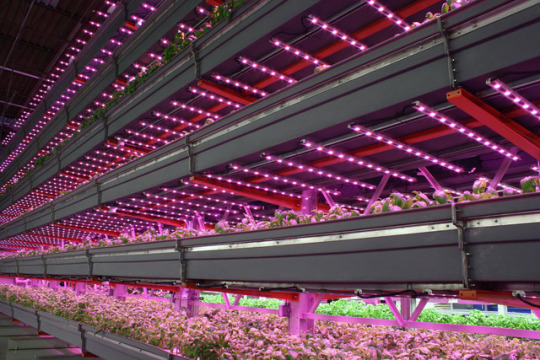
Can Vertical Farms Reap Their Harvest? It’s Anyone’s Bet.
CONTENT SOURCED FROM CIVILEATS
By now, the images of shelves full of perfect greens in hulking warehouses, stacked floor to ceiling in sterile environs and illuminated by high-powered LED lights, have become familiar. Food futurists and industry leaders say these high-tech vertical farming operations are the future of agriculture—able to operate anywhere, virtually invincible against pests, pathogens, and poor weather, and producing local, fresh, high-quality, lower-carbon food year-round.
That future seemed one step closer to reality last year when San Francisco-based indoor farming startup Plenty, which grows a variety of salad and leafy greens hydroponically (without soil) and uses artificial lighting in facilities in three locations, announced that it had raised a whopping $200 million in funding from the SoftBank Vision Fund, whose investors include Amazon founder Jeff Bezos.
Flush with cash, Plenty quickly opened a 100,000-square-foot indoor farm outside Seattle that promised to produce 4.5 million pounds of greens annually—including some varieties not yet grown for the masses at scale, such as hydroponic peaches, carrots, and watermelon. To Plenty’s leadership and many observers, the cash influx signaled the economic promise of growing food indoors without sunlight and with less soil and water than field farming.
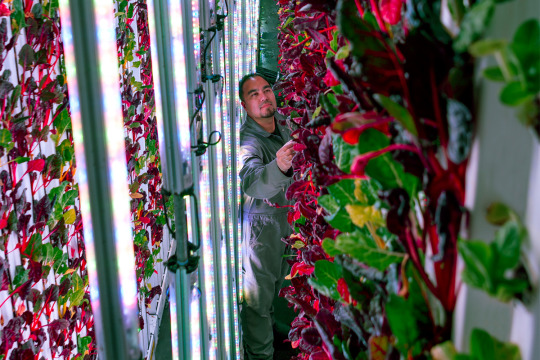
(Photo courtesy of Plenty)
“My reaction [to the $200 million round] was both that of validation, excitement,” said Matt Barnard, Plenty’s co-founder and CEO, over a manner of farming he says yields 350 times the produce per acre on one percent of the water used by dirt farming. “Now we must move with speed and efficiency if we’re to accomplish our mission of bringing people worldwide an experience that’s healthier for them and the planet.”
Not everyone is in agreement.
“My first thought was, ‘we could build a lot of greenhouses for $200 million,’” recalls Neil Mattson, a professor of plant science at Cornell and one of the country’s leading academic voices on indoor agriculture, who’s found that high-tech greenhouses that harness sunlight are more cost- and carbon-friendly than vertical farms that use artificial light.
Most vertical farmers are only hoping to claim a percentage of the conventional produce market, not replace it. To these founders and their investors, the market for lettuce and greens, especially—grown primarily in California and Arizona and shipped worldwide—is ripe for disruption. E. colioutbreaks like the one that hit Arizona-grown romaine lettuce earlier this year, killing a handful of people and sickening hundreds, only further their case.
But behind futurists’ fervent predictions about indoor agriculture, claims about product quality, and sexy technology lies a reality known by industry insiders but too often missing from media coverage: The future success of this nascent industry is still very much an open question.
The astronomical capital costs associated with starting a large hydroponic farm (compared to field and greenhouse farming), its reliance on investor capital and yet-to-be-developed technology, and challenges around energy efficiency and environmental impact make vertical farming anything but a sure bet. And even if vertical farms do scale, there’s no clear sense of whether brand-loyal consumers, en masse, will make the switch from field-grown produce to foods grown indoors.
Tricky Economics
Walking into any supermarket will reveal a small mountain of salad greens, carrying a price tag of between $9 and $12 per pound. They may be locally grown or organic, which will add $0.50 or $1 to the price tag. Meanwhile, a 4.5-ounce carton of Massachusetts-based FreshBox Farms’ spring mix—grown in the company’s hydroponic farm in Massachusetts—costs $3.99 for a 4-ounce box, or $15.96 per pound. Or kale: the conventional variety will run you $1.33 per pound at Walmart; organic kale costs around $4.99 per pound at Whole Foods; and vertically farmed kale grown at Newark, New Jersey-based AeroFarms will cost you a whopping $14.18 per pound.
That dramatic price gap is due to the millions of dollars currently needed to build one large indoor vertical farm—and that price is not going to drop until the industry scales up. Agritecture Consulting, whose clients include current and prospective indoor farms, estimates that a 30,000-square-foot vertical farm growing leafy greens and herbs in the tri-state area around New York City requires nearly $4 million in startup capital—not including labor.
They should know: In 2016, Agritecture built farm.one in Manhattan’s TriBeCa neighborhood, which supplies hydroponic greens and edible flowers to a number of the city’s top restaurants. Chefs have been quick to catch onto the value of consistent, year-round, locally grown produce.
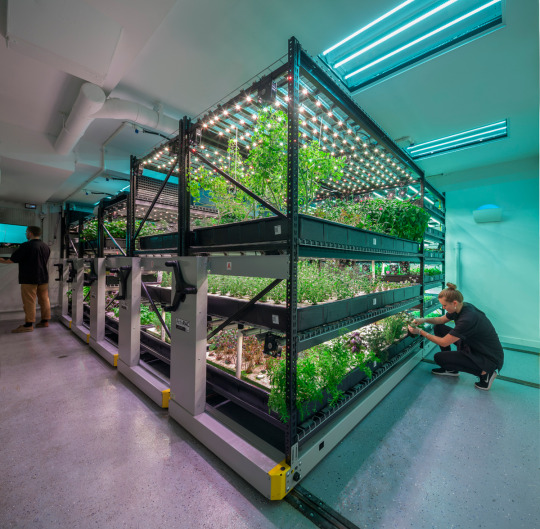
A farm.one indoor farming operation. (Photo courtesy of farm.one)
In 2016, AeroFarms, now considered an industry leader, spent $30 million on its flagship aeroponic farm in Newark. The majority of these costs lie in the equipment needed to grow greens without soil or sunlight—heating and cooling systems, ventilation, shading, environmental controls, and lights.
All of these costs add up to a hefty electricity bill: According to models compiled for Civil Eats by Agritecture, a 30,000-square-foot vertical farm in metro New York City should budget upwards of $216,000 annually for lighting and power, and another $120,000 on HVAC systems; costs will vary region to region depending on what each state charges for electricity.
Energy and equipment costs are, by far, the largest drivers of expenses that can bring the price of operating a vertical farm close to $27 per square foot. By contrast, Agritecture’s models show that the cost to run a 100,000-square-foot smart greenhouse is roughly a third as expensive, thanks to the use of natural sunlight and more advanced automation.
Vertical farms’ energy usage carries a significant carbon footprint. While vertical farm companies promise more-sustainable produce by growing it closer to consumers and using renewable energy to power their operations, the industry still has a long row to hoe.
Industry leaders acknowledge the energy challenges in the short term, yet tout continually improving lighting technology that has brought down costs. But Mattson, whose Cornell team studies the way plants respond to different lighting, predicts a plateau coming for improvements to LED technology.
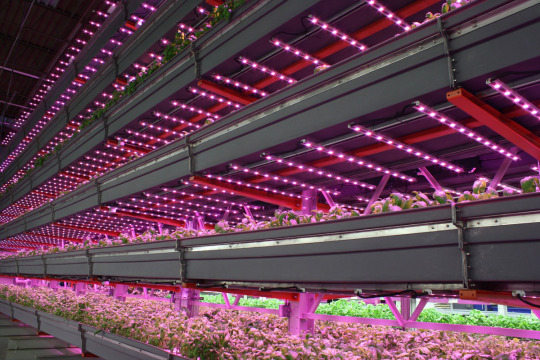
LEDs lighting an indoor farming operation. (Photo courtesy of Agritecture)
“The best LEDs are 40 percent more energy efficient than in 2014,” Mattson says. “There continue to be improvements; however, those improvements will start to slow down over time. There’s only a finite amount of light you can generate at a given wavelength, and in 2022, I’m not expecting new lights to be 40 percent more efficient than the current lights now.”
FreshBox Farms began shipping greens from its 40,000-square-foot hydroponic facility in Millis, Massachusetts, in 2015. The warehouse farm, located 30 miles outside of Boston, runs on a combination of renewable energy and non-renewables, and CFO Dave Vosburg admits his company is “not doing any better” than field-grown greens when it comes to carbon usage.
When it eventually expands outside of Massachusetts, Vosberg says that by introducing a cogeneration system—technology that recycles otherwise wasted heat into new energy—FreshBox Farms will eventually keep costs and carbon emissions down in expensive markets like Connecticut, where commercial users pay an average of more than 14 cents per kilowatt-hour. But Vosburg says the company’s priority is to use contextually appropriate renewable energy sources to power the farms, such as wind energy in the Midwest, hydro in the Northwest, and solar in the Southwest.
“Yes, it sounds crazy to take the sun and turn it into electricity and turn that electricity back into light. It sounds ridiculous, but that’s what we’ll be doing,” Vosburg says. “It’ll be really efficient and clean and create a better product, and it won’t have the same carbon impact that we’re having today.”
And energy isn’t even a vertical farm’s top ongoing expense. The companies Civil Eats spoke to say labor is actually their largest budget item. Vertical farms typically pay workers higher, more metropolitan pay rates than both dirt farms—many of which rely heavily on migrant labor—and the more automated smart greenhouses. The fast-food chain Wendy’s announced in June that it plans to source vine-ripened tomatoes exclusively from greenhouse farms by early 2019.
Moreover, no matter how automated the indoor growing system is, vertical farmers are discovering the constant need for a human eye—or several—on the process. In fact, some estimate that if indoor agriculture continues to grow at the pace it has in recent years, vertical farms will have to hire 100,000 workers over the next decade.
That continued growth is not a given, however. Because of the high cost to launch, operate, and scale up a vertical farming operation, the industry is highly leveraged, with each new farm requiring tens of millions of dollars in investor capital before it can grow a single plant. Between 2016 and 2017, investments in vertical farming skyrocketed 653 percent, from $36 million to $271 million. The lion’s share of that investment went to Plenty, but Newark-based AeroFarms has raised $80 million in recent years and Brooklyn’s Bowery Farming added another $27 million.
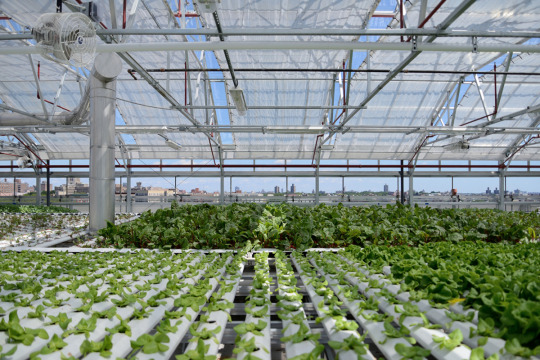
Sky Vegetables’ rooftop hydroponic farming operation in New York City. (Photo courtesy of Agritecture)
Just last week, Manhattan-based BrightFarms announced it had raised $55 million. Shoppers can now find produce grown indoors by more than 23 large vertical farms in more than 20 supermarket chains in nearly every major metropolitan area in the country, according to Agritecture.
While industry leaders say scaling offers the best hope for profitability in this business, many vertical farms have encountered problems when they began planning to add additional production facilities. Before Atlanta-based PodPonics closed its doors in 2016, executives from the five-year-old hydroponic farm startup met with executives from supermarket chain Kroger.
Kroger indicated that it was ready to purchase 25 million pounds of produce from PodPonics annually if it would build the facilities to support that kind of production, founder Matt Liotta told a crowd at the 2017 Aglanta Conference. According to Liotta, who said PodPonics had lowered the cost to produce a pound of lettuce to $1.36, Whole Foods and Fresh Market also expressed interest in bringing PodPonics greens into their stores nationally.
“This was our wildest dream,” Liotta said. “Then we realized how much capital that was going to require, how many people we were going to have to hire. Every retailer told us the same thing: ‘We will buy it if you will build it.’ We realized we were incapable of building everything that they wanted.”
Unproven Demand for Food Grown Indoors
In early 2016, researchers from the University of Illinois-Urbana set out to determine whether consumers would spring for produce grown indoors. They asked a panel of 117 participants a series of questions about their perceptions of and willingness to pay for lettuce grown in fields, greenhouses, and in vertical farms. While vertical farming ranked fairly high in terms of produce quality and safety, the tech-heavy production method was rated less “natural” than both field farming and greenhouse and ranked last in participants’ willingness to purchase it.
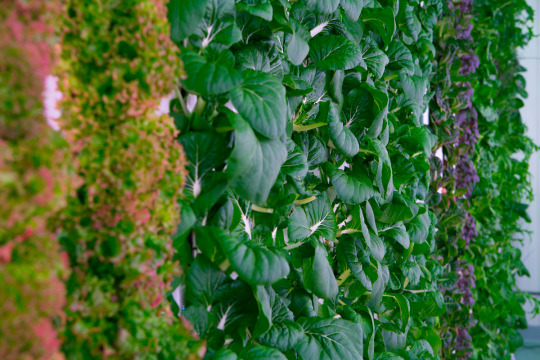
(Photo courtesy of Plenty)
For the vertical agriculture industry to eat into the profits of field-grown products—a roughly $140 billion industry—Agritecture Consulting founder and managing director Henry Gordon-Smith says it will first need to prove consumers are demanding produce grown indoors. He points out that because of a lack of demand, many vertical farming operations are not yet at full production year-round—despite touting the 12-month growing season as a main benefit of the industry.
His sense is that indoor farms that have achieved the sales to produce continually—such as Gotham Greens has with its New York City greenhouses, for example—have a customer base that’s responding to strong “local” branding rather than the technology behind the food. That may include vertical farms selling their produce using the USDA Certified Organic label, which the National Organic Board reaffirmed in January, much to the dismay of many organic dirt farmers.
“I think the automation and economics are all improving,” Gordon-Smith says, adding that the question of “whether consumers are going to pay more or whether the products coming out of vertical farms are going to align with their values” is still an open question.
But while many of the East Coast vertical farms built their business models around replacing greens being shipped cross-country from California and Arizona, Matt Barnard of Plenty hopes to add to the global population consuming fresh produce. A 2015 report found that where USDA guidelines suggest each of us in the U.S. should eat up to three cups of vegetables daily, current U.S. production is only providing enough for 1.7 cups per person. Barnard extends that supply gap to the rest of the world, especially the Middle East and Asia, where a lack of water and high pollution have hampered agriculture.
“We believe the industry will be five times larger when there is supply to meet the demand,” Barnard says. “With the field unable to deliver consistent supply, new forms of agricultural capacity like Plenty must be added to the global food system.”

Plenty CEO Matt Barnard. (Photo courtesy of Plenty)
But as vertical farming companies like Plenty go city by city attempting to dominate local markets, it may be that small farmers get hurt the most. Barnard drew the ire of Washington State dirt farmers last year when he told GeekWire that Plenty expanded to Seattle, in part, because it was the West Coast’s “best example of a large community of people who really don’t have much access to any fresh fruits and vegetables grown locally.”
Not so, according to Sofia Gidlund, Farm Programs Manager at Tilth Alliance, which advocates for and supports local agriculture systems in Greater Seattle.
“We work with many hardworking local farmers who supply Seattle with high-quality, delicious, and nutritious food while caring deeply for our land. These farmers use sustainable farming practices, nurse the soil, create beautiful open green space and provide wildlife habitat,” says Gidlund, who adds that she does not speak for all area farmers on the issue of vertical farming. “Many consumers in Seattle choose to support local farmers, both urban or rural, because of this deep connection to the land. Providing that support is a point of pride for many Seattleites.”
Actual Data Is Coming
Peer-reviewed research into the business of vertical farming has been sparse, partly because the industry is so new. That’s set to change, however, when Mattson and a team of researchers at Cornell University finish a comprehensive study into the viability of this approach.
A three-year, $2.4 million research grant, which is funded by the National Science Foundation and kicked off in January, will compare the vertical farming industry to field agriculture in a slew of categories, including energy, carbon, and water footprints, profitability, workforce development, and scalability. The study will include one of the first nutritional analyses of food grown indoors, as well as comparing the price-per-pound to deliver strawberries, lettuce, and tomatoes grown vertically and outdoors to five U.S. metropolitan areas: New York City, Chicago, Seattle, Los Angeles, and Atlanta.
A 2016 study conducted by a few of Mattson’s colleagues at Cornell found that the energy consumption and carbon footprint associated with a vertical farm (the study calls it a “plant factory”) is significantly higher than that of a greenhouse. Vertical farming leaders counter that they use significantly less water than field farms, are more space-efficient, and do not produce emissions from trucking produce across the country. Mattson says these factors were not considered in Cornell’s previous research but will be included in the current grant.
“[Vertical farming] is not a fad,” says Mattson, who wants to use data to help the industry become more sustainable over time. “I’m not sure to what degree it’s going to scale up, but this is happening. So we need to understand the economic and environmental implications—both the good and the bad.”
by STEVE HOLT
#urban agriculture#urban farming#indoor ag#vertical farming#hydroponic#local food#agtech#double-size
36 notes
·
View notes
Photo
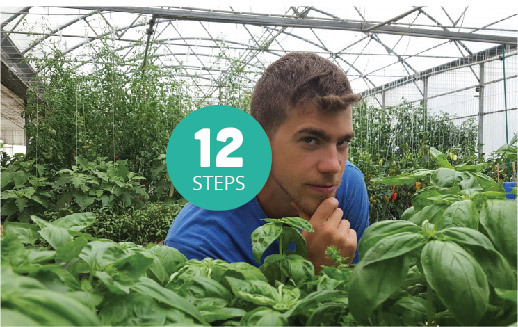
12 steps to become an Urban or Vertical Farmer
The 12 Step Farmers have just released their 2017 season of the 12 Step Guide to becoming an urban farmer. Each step features in depth interviews and farm tours with successful pioneers from across the globe in the urban and vertical farming movement. You will learn about different crops, growing methods, marketing and business strategies, finance, policy, architecture and so much more. There is also a secret 12 steps community where you can connect to the pioneering farmers!
Agritecture’s very own Henry Gordon-Smith is featured in this year’s guide. In the interview he gives advice to entrepreneurs looking to start their own urban farm, such as how to select your site and plan out the space.
Lifetime access to the 12 Step Guide, including over 10 hours of lessons from 12 Steps 2017, is on sale right now for €59.99.
Click here to start your journey towards becoming an urban farmer!
#urban agriculture#urban farming#vertical farming#guide#growfood#greenhouse#hydroponic#CEA#indoor ag
28 notes
·
View notes
Photo
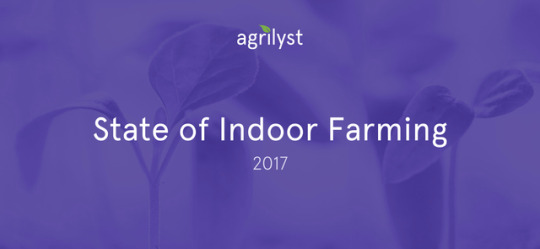
Survey Says That Shipping Container Farms Are Most 'Overhyped' Technology
The data mavens at Agrilyst have done it again! The 2017 State of Indoor Farming Report provides insight from 150 indoor farmers about their operations, priorities, and even their perspectives on various technologies. Be sure to read the whole report to gain insight into what's working and what's not when it comes to indoor farming.
Here are three key takeaways that we found particularly interesting from the survey this year:
1. Shipping Container Farms are Most 'Overhyped' Technology
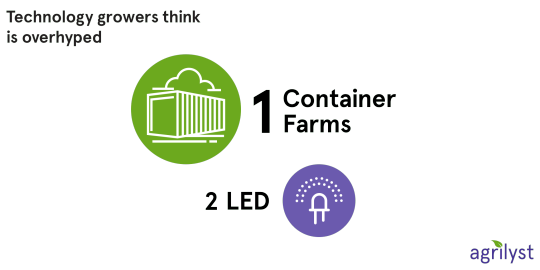
"While LEDs are one of the things growers are most excited about, it also came in second on the list of things growers think are over-hyped. The overwhelming number one on the list of doubtful technologies was container farms."
The results of Agrilyst's survey adds to a growing number of voices including Nate Storey who are concerned about the performance and scalability of shipping container farms. This collective awareness could mark the end of the "farm-in-a-box era".
2. IOT & Automation Will Proliferate Indoor Farming in 2018
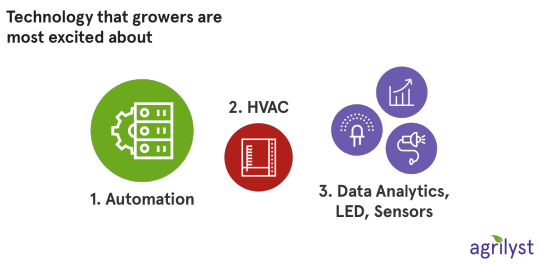
"Automation tops the list of technologies growers are most excited about. Second to automation is HVAC (heating, venting, and air conditioning) equipment. Third was a tie between data analytics, LEDs, and sensors. Note this was an open-ended question and for sensors, most growers indicated an interest in sensors specifically for nutrient applications. Automation is not a surprising number one. With the high cost of labor, most growers are thinking strategically about investing in technology that can bring costs down."
These results come after a year where Autogrow announced new API for indoor farming sensors, AeroFarms partnered with Dell for IOT in their farms, and IOT + Ag was voted one of the top 10 Smart Tech trends of 2018. These topics will be covered in detail during the AgLanta 2018 Smart Ag for Smart Cities Conference on March 27 & 28.
3. At Least Half of Indoor Farms are Not Profitable Yet
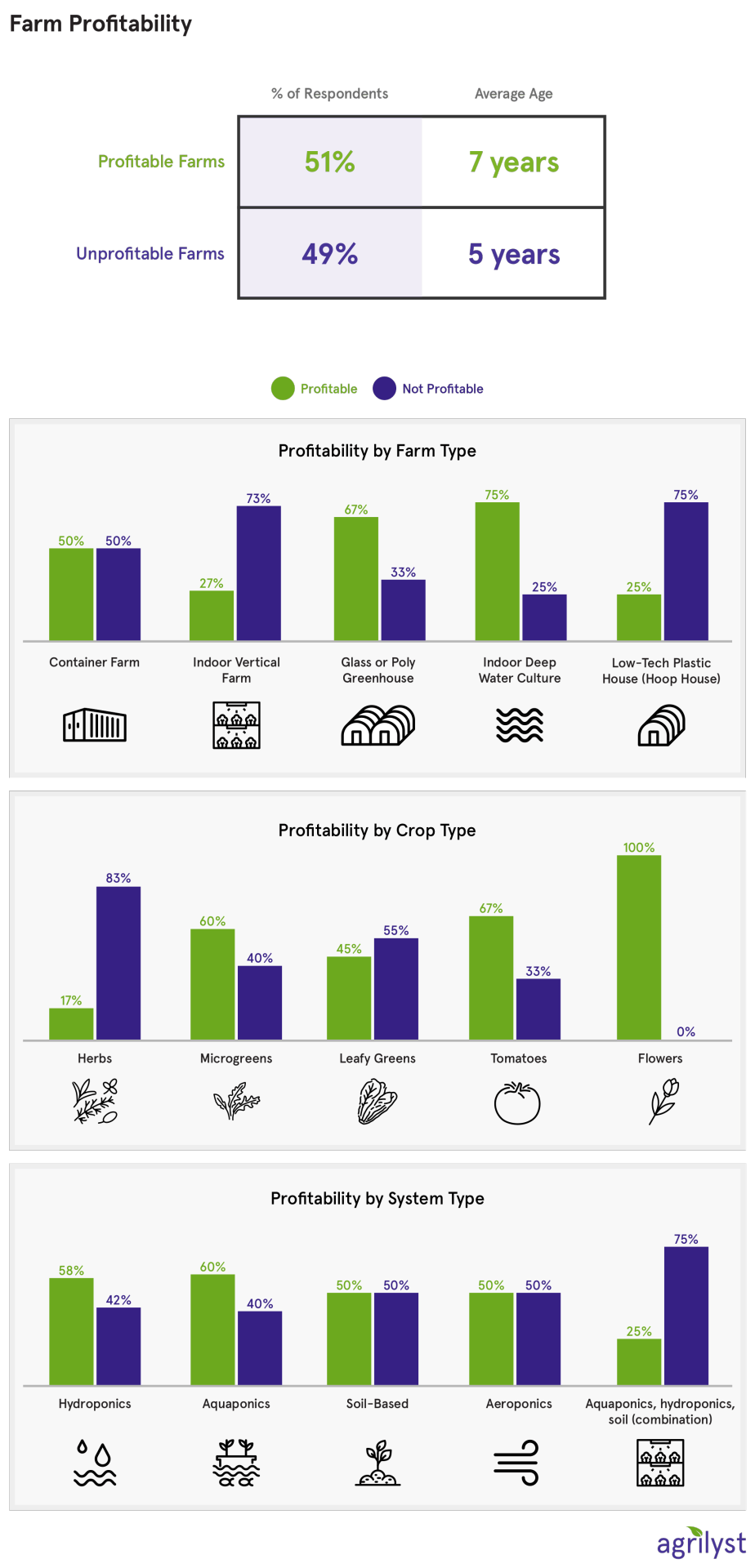
"Of the facility types we surveyed, the most profitable appeared to be indoor deep water culture, followed by greenhouse operations. Of the five most commonly grown crops, 100% of flower operations reported profitability, along with 67% of tomato growers, and 60% of microgreens growers. The most profitable system types were hydroponics and aquaponics.
The facility types with least profitability reported were indoor vertical farms and low-tech plastic houses. Similarly, herbs and leafy greens were the least profitable crops. The combination operations (using multiple system types) were overwhelmingly unprofitable.
Tomatoes, microgreens, and flowers are most likely profitable because microgreens have extremely high revenue per pound, and flower and tomato producers have lower operating costs. Vertical farms reporting limited profitability is most likely because it is a new industry that is just beginning to mature."
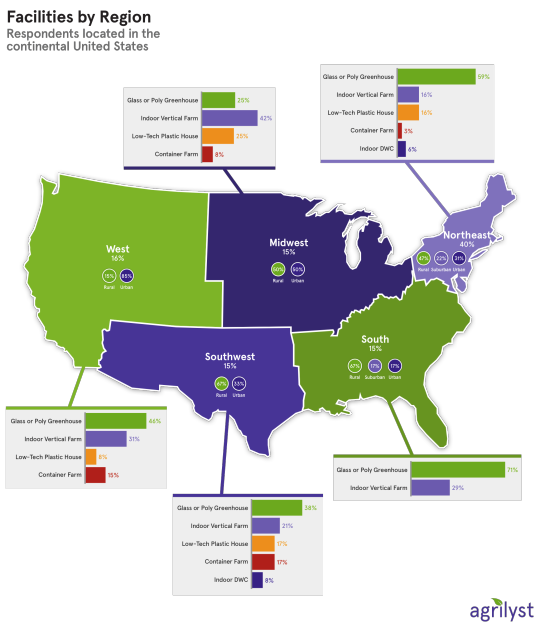
Indoor Farming continues to be an exciting and challenging business venture. Remember that proper planning prevents poor performance. Consider hiring a consultant to guide you through the noise and marketing of technology suppliers. Also, be sure to listen to our podcast with Allison Kopf, CEO of Agrilyst and Henry Gordon-Smith, Founder at Agritecture to learn about the 3 main mistakes indoor farmers make and how to avoid them. Listen here. Want to meet Allison Kopf in person? Hear her speak on Smart Resource Management at the AgLanta 2018 Conference. Earlybird tickets on sale here.
16 notes
·
View notes
Photo
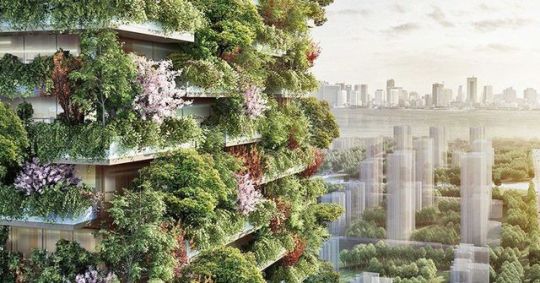
CHINA PLANS TO BUILD NEARLY 300 NEW ECO-CITIES
CONTENT SOURCED FROM GREENMATTERS
China is not exactly known for its eco-conscious ethos. In fact, it's one of the world's biggest polluters, with limited environmental regulation stopping the flow of toxins into the environment. Even the regulations that do exist are often ignored by large companies – some 70 percent of businesses examined by environmental inspectors failed to meet environmental standards for controlling air pollution, according to a state news agency report.
Now, according to the Chinese Ministry of Health, industrial pollution has made cancer China's leading cause of death. Every year, ambient air pollution alone kills hundreds of thousands of citizens, and 500 million people in the nation are without safe and clean drinking water.
But as it turns out, the country is trying to reverse its massive carbon footprint. Earlier this year, China broke ground on a 40,000-tree-filled Forest City, a futuristic metropolis that will use renewable energy for self-sufficiency and be blanketed in almost 1 million plants, which will be capable of absorbing nearly 10,000 tons of carbon dioxide and 57 tons of pollutants a year. Ambitious as that was, China is taking this concept even further – this week, the country announced plans to plan a total of 285 such eco-cities.
The cities will span across the country, from the eastern seaboard to the fringes of Central Asia, from Inner Mongolia to jungle-filled south, with 80 percent of all prefectural-level cities now having at least one eco-city project in the works. It's estimated that in the near future over 50 percent of China’s new urban developments will be “eco,” “green,” “low carbon” or “smart," a figure that could have a drastic impact on the environment, even if only a portion of them are built.
Of course, China is not prone to dishing out all the juicy details about what exactly these eco-cities will look like, and very few people have attained access to plans. But Jiaotong-Liverpool University professor and writer Austin Williams' new book China’s Urban Revolution: Understanding Chinese Eco-Cities has some answers.
First of all, according to Williams, “there is no definition of an eco-city, which makes them incredibly easy to invent." While China has a “Three Star” system, which measures the green and low-carbon standards of individual buildings, and LEED ratings, there is no all-encompassing set of standards for cities. That means the term “eco-city” is "little more than a conceptual framework at best, a rather effective marketing strategy at worst, and we need to take the words of government officials, designers, and developers at face value when they claim to be building cities of such distinction," according to Forbes.
That said, China's intention does seem to be to build cities that are less environmentally detrimental and more livable. "Basically, they are cities that claim to bridge the human/nature divide, pollute less, use less resources, emit lower amounts of carbon, utilize renewable energy, recycle more, have a higher percentage of energy-efficient buildings, are set up for lower-carbon means of transport, and are posited as models for the way humanity will live next," according to Forbes.
READ MORE ON THE NEW AGRITECTURE BLOG
#eco-city#eco-conscious#agritecture#architecture#smart growth#city planning#low carbon#carbon footprint#sustainability#green space#china#renewable energy#energy efficiency
28 notes
·
View notes